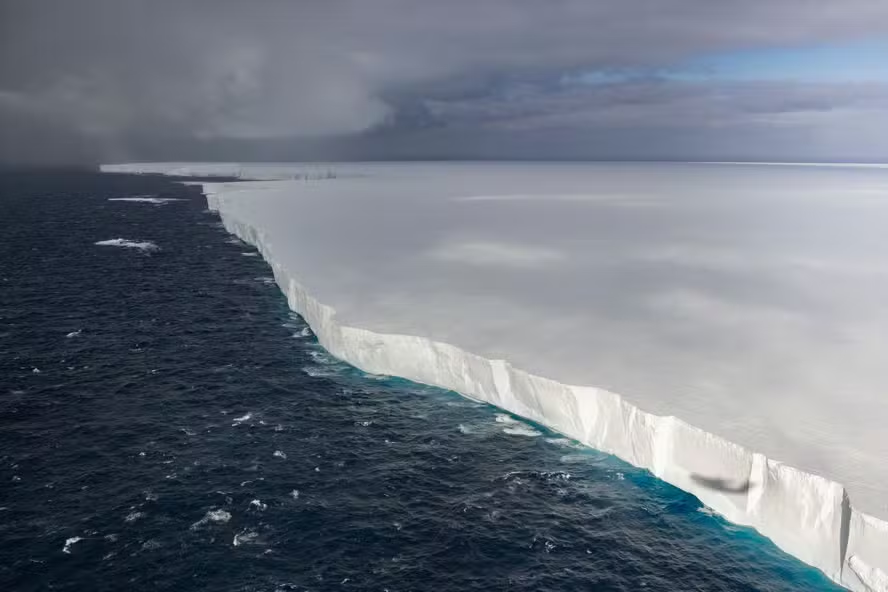The A23a iceberg, currently the largest in the world, recently became the center of attention after it grounded off South Georgia Island, a remote island located in the South Atlantic Ocean, which is a British Overseas Territory. This event, following a journey of over three years, raised alarms within the scientific community as the giant iceberg, covering an area of 3,672 square kilometers, is more than twice the size of London and only slightly smaller than the state of Rhode Island in the United States.
This colossal block of ice, weighing an estimated nearly one trillion metric tons (about 1.1 trillion tons), began its journey in 1986 when it detached from the Filchner Ice Shelf in Antarctica. For over 30 years, A23a remained trapped in the frozen waters of the Weddell Sea, a remote and largely unexplored area of the Antarctic continent. It wasn’t until 2020 that the iceberg, after long years of immobility, was released by ocean currents and began its northward journey towards the South Atlantic Ocean.

In 2024, scientists observed with great interest that the iceberg was nearing South Georgia Island but became trapped around an underwater mountain about 90 kilometers off the coast. This halted its trajectory and sparked a series of speculations about the potential impacts of this phenomenon on the local wildlife. Due to its colossal size and the historical precedent that icebergs of this magnitude can have destructive effects on the regions they traverse, many concerns arose, particularly regarding the disruption of feeding areas for endemic species on the island, such as seals and penguins, which rely on these zones for survival and reproduction.
However, initial concerns began to diminish with new observations. According to experts from the British Antarctic Survey (BAS), although A23a had grounded, its position appeared to be far enough from the main feeding areas to avoid causing direct harm to these populations. Andrew Meijers, a marine scientist from BAS, explained that, if the iceberg remains grounded, it is unlikely to significantly affect the local wildlife. Furthermore, he suggested that rather than harming the island’s ecosystems, the iceberg could have positive effects on marine fauna. The gradual melting of the iceberg would release nutrients into the marine environment, potentially boosting the abundance of food and benefiting a variety of species, including penguins, seals, and other marine creatures inhabiting the region.
While A23a has so far resisted fragmentation, experts warn that this is only a matter of time. Giant icebergs have a vulnerable structure, and scientists believe that, over time, A23a will likely break apart due to increased internal stresses caused by its own weight and the dynamics of the marine environment. This is a natural process, as icebergs of this size often fragment after some time exposed to the heat of the water and the constant movement of currents. However, the exact moment of this occurrence remains uncertain, and scientists are still unable to predict when A23a will completely fragment.
This fragmentation process could have significant implications for human activities in the region. While A23a is large enough to be easily detected and monitored, the smaller pieces of ice that emerge after its fragmentation pose a much greater risk to navigation and fishing operations. These smaller pieces are harder to detect and, therefore, more dangerous for ships navigating the area. Indeed, fishing operators have already mentioned that the presence of large icebergs in an area can create a “minefield” of smaller fragments that are difficult to track, making fishing and navigation significantly riskier.
Historically, large icebergs that have detached from the Antarctic ice shelves and traveled north have posed considerable threats to the fishing and transportation industries. Some of these icebergs, like A23a, end up creating “no-fishing” zones because the smaller icebergs that break off during fragmentation are particularly treacherous. According to fishing operators, these zones may remain closed for extended periods, impacting the local economy and even the supply of fishery resources to other regions.
Although the detachment of A23a occurred as part of the natural cycle of growth and aging of the Antarctic ice shelves, the increasing concern over global warming also plays a significant role in this phenomenon. Scientists point out that climate change, primarily driven by greenhouse gas emissions, is accelerating the processes of melting and fragmentation of ice shelves, resulting in a greater number of icebergs breaking off from the ice shelves.
These processes have broader implications for future sea levels. The melting of Antarctic ice shelves contributes significantly to rising global sea levels, which poses a threat to coastal areas worldwide. The impact of A23a, while specific to the South Georgia region, serves as a reminder of the effects climate change is having on polar regions and how these phenomena can affect wildlife, human communities, and economic activities in the more remote regions.
A23a is undoubtedly one of the largest icebergs to be recorded in recent times, and its journey to South Georgia is a fascinating example of the dynamics of ice systems and how ocean currents can influence the fate of these giant masses of ice. Monitoring its trajectory in the coming years will be essential for scientists, as it offers a unique opportunity to study how these massive ice blocks interact with marine ecosystems and how climate change may accelerate the process of detachment and fragmentation of ice shelves in Antarctica.
Additionally, A23a represents a metaphor for how Earth’s natural systems are interconnected and how the impact of a simple change in a remote region can have global repercussions. The melting and fragmentation of icebergs like A23a can not only alter local marine ecosystems but also accelerate rising sea levels, with unpredictable consequences for coastal communities worldwide. Continued observation of this iceberg and similar phenomena will be crucial to better understanding the pace and impacts of climate change and to planning the necessary responses to mitigate its effects.

